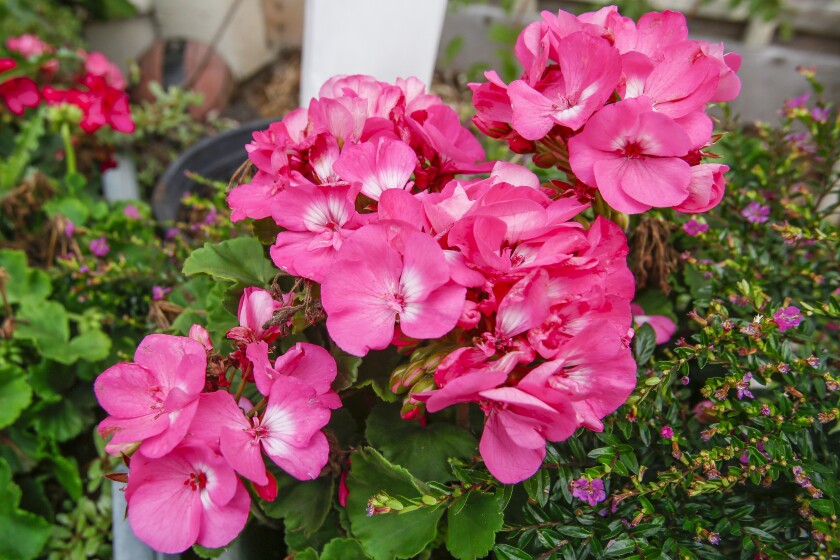If you could take a sunny disposition, contentment, and good old-fashioned reliability and create a flower, it would be the geranium. They’ve been gracing our homes since pioneer days and are an ever-popular staple in outdoor pots, planters and flower beds. Geraniums are also the most popular plant for bringing indoors in fall and keeping over winter so they can go outside again next spring.
There are different ways to keep geraniums from year to year. Some gardeners move their potted geraniums to a cool spot in the basement, where they remain partially dormant during winter with minimal watering, and are brought back into active growth in spring. A few people follow the old-time practice of storing geraniums bare-root in a root cellar-type atmosphere. Several well-experienced gardeners have told me their geraniums have cycled outdoors and indoors for over 30 years.
ADVERTISEMENT
My wife, Mary, and I bring 100 geranium plants or cuttings indoors each fall to keep for next spring’s outdoor containers. It doesn’t require as much room as it sounds, using a successful method that saves space, rejuvenates older plants and is easy.
RELATED COLUMNS:
Tree planting guidelines have changed
|
View annual flowers now to get ideas for next year
|
September checklist for a busy month of lawn and garden tasks
|
|
It's time to dig, divide and plant iris
Here’s the recipe for wintering a quantity of geraniums that will rival greenhouse-quality plants by next spring:
- Before they’re injured by fall frost, remove geraniums from outdoor planters or flower beds by gently digging or lifting out the plant and its roots.

- Geraniums often become large over summer. Instead of trying to overwinter large geraniums, I prefer to cut each plant back to 3 inches above soil level. This removes most of the tops, leaving only stems and a few lower leaves. More plants fit in a limited space, and they quickly sprout new healthy, compact growth.
- The goal is to produce compact, well-branched plants in 4- or 5-inch pots, similar to what we’d buy at a greenhouse in spring.

ADVERTISEMENT
- Pot the pruned geraniums into individual 4- or 5-inch diameter pots using top-quality soil like Miracle-Gro Potting Mix, or a mix recommended by your locally owned garden center. Geraniums grow best indoors if there’s one plant per pot, instead of multiples in a large pot.
- Geraniums enjoy being “pot-bound” so don’t use large pots indoors.

- Place in a window where the plants will receive direct sunshine. South windows are best, followed by east and west.
- If a large, sunny window is lacking, geraniums grow very well under fluorescent or LED lights, with automatic timers set for 16 hours on and 8 hours off. We grow ours in a corner of the basement under shop-type fluorescent hanging fixtures containing one warm and one cool tube. Locate plants so the lights are within an inch or two of the geranium tops.

- Fertilize once a month with a water-soluble fertilizer.
- Allow the geranium soil to dry out very well between waterings. If a finger inserted to the first joint feels any moisture at the fingertip, don’t water. If in doubt, wait a day and then check again. Geraniums easily rot if kept too moist. If in question, err on the dry side.
- Continue to grow the plants during winter as you would houseplants, enjoying the blossoms that arise by midwinter. About March 1, pinch back any winter growth that became spindly, and remove blossoms and flower buds. Begin water-soluble fertilizer every two weeks. The geraniums will branch beautifully and will be in prime conditions for planting outdoors in May.
Besides overwintering the original plants, I like to start some fresh geranium cuttings each fall from the tips of plants I cut back. When rooted, they provide new plants to replenish any that are old and woody. Geranium cuttings, about 3 inches long, produce roots in two to three weeks in a mixture of half sand, half peat moss. When roots are about 2 inches long, plant into potting mix in 4-inch diameter pots, and grow as directed above.
Don Kinzler, a lifelong gardener, is the horticulturist with North Dakota State University Extension for Cass County. Readers can reach him at donald.kinzler@ndsu.edu or call 701-241-5707.
ADVERTISEMENT











